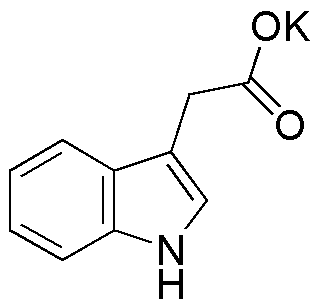3-Indoleacetic acid potassium salt is widely utilized in research focused on:
- Plant Growth Regulation: This compound acts as a plant hormone, promoting root formation and enhancing overall plant growth. It is especially beneficial in agriculture for improving crop yields.
- Cell Culture Studies: In laboratory settings, it is used to stimulate cell division and differentiation in various cell lines, making it a valuable tool for researchers studying cellular processes.
- Neuroscience Research: The compound has been investigated for its potential neuroprotective effects, providing insights into treatments for neurodegenerative diseases.
- Pharmaceutical Development: It serves as a precursor in the synthesis of various pharmaceutical compounds, aiding in the development of new medications.
- Biotechnology Applications: Used in genetic engineering, it helps in the transformation of plant cells, facilitating the introduction of new traits for improved plant varieties.
Informations générales
Propriétés
Sécurité et réglementation
Applications
3-Indoleacetic acid potassium salt is widely utilized in research focused on:
- Plant Growth Regulation: This compound acts as a plant hormone, promoting root formation and enhancing overall plant growth. It is especially beneficial in agriculture for improving crop yields.
- Cell Culture Studies: In laboratory settings, it is used to stimulate cell division and differentiation in various cell lines, making it a valuable tool for researchers studying cellular processes.
- Neuroscience Research: The compound has been investigated for its potential neuroprotective effects, providing insights into treatments for neurodegenerative diseases.
- Pharmaceutical Development: It serves as a precursor in the synthesis of various pharmaceutical compounds, aiding in the development of new medications.
- Biotechnology Applications: Used in genetic engineering, it helps in the transformation of plant cells, facilitating the introduction of new traits for improved plant varieties.
Documents
Fiches de données de sécurité (FDS)
La FDS fournit des informations de sécurité complètes sur la manipulation, le stockage et l’élimination du produit.
Spécifications du produit (PS)
Le PS fournit une description complète des propriétés du produit, notamment sa composition chimique, son état physique, sa pureté et les exigences de stockage. Il détaille également les plages de qualité acceptables et les applications prévues du produit.
Certificats d'analyse (COA)
Recherchez des certificats d'analyse (COA) en saisissant le numéro de lot du produit. Les numéros de lot et de lot se trouvent sur l'étiquette d'un produit, après les mots « Lot » ou « Lot de fabrication ».
Numéro de catalogue
Numéro de lot/série
Certificats d'origine (COO)
Ce certificat d'exploitation confirme le pays dans lequel le produit a été fabriqué, et détaille également les matériaux et composants utilisés et s'il est issu de sources naturelles, synthétiques ou autres sources spécifiques. Ce certificat peut être requis pour les douanes, le commerce et la conformité réglementaire.
Numéro de catalogue
Numéro de lot/série
Fiches de données de sécurité (FDS)
La FDS fournit des informations de sécurité complètes sur la manipulation, le stockage et l’élimination du produit.
DownloadSpécifications du produit (PS)
Le PS fournit une description complète des propriétés du produit, notamment sa composition chimique, son état physique, sa pureté et les exigences de stockage. Il détaille également les plages de qualité acceptables et les applications prévues du produit.
DownloadCertificats d'analyse (COA)
Recherchez des certificats d'analyse (COA) en saisissant le numéro de lot du produit. Les numéros de lot et de lot se trouvent sur l'étiquette d'un produit, après les mots « Lot » ou « Lot de fabrication ».
Numéro de catalogue
Numéro de lot/série
Certificats d'origine (COO)
Ce certificat d'exploitation confirme le pays dans lequel le produit a été fabriqué, et détaille également les matériaux et composants utilisés et s'il est issu de sources naturelles, synthétiques ou autres sources spécifiques. Ce certificat peut être requis pour les douanes, le commerce et la conformité réglementaire.


